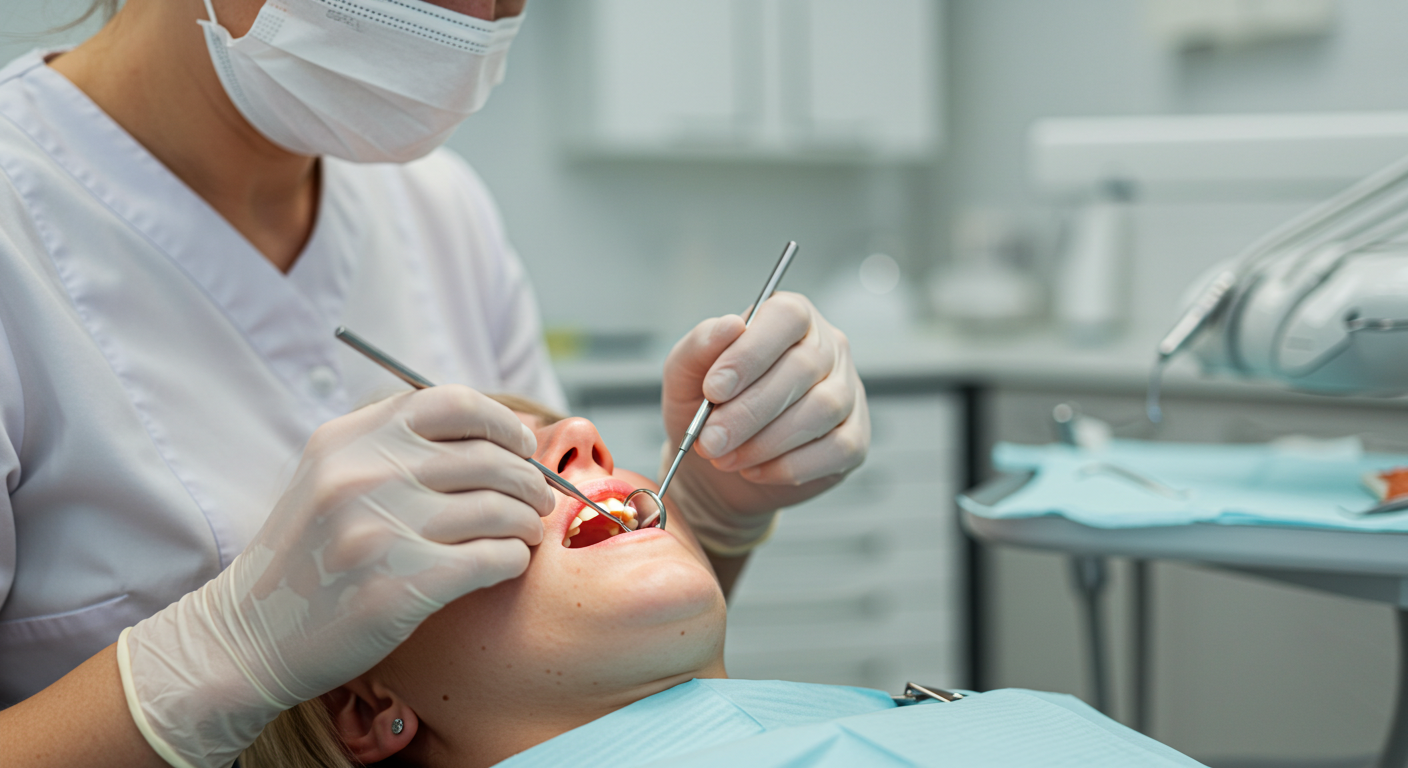Contents

What is Dental Scaling and Root Planing?
Rigorous oral hygiene is the foundation of a healthy smile. However, sometimes brushing and flossing are not enough to remove all the bacteria and hardened plaque (tartar) that accumulate, especially below the gum line. When this happens, your dentist may recommend a therapeutic procedure known as scaling and root planing, often referred to as a "deep cleaning."
What is it exactly? Is it painful? This guide will demystify this common periodontal procedure and explain its crucial role in treating gum disease.
What is Scaling and Root Planing?
It is a non-surgical, deep cleaning procedure performed by a dentist or periodontist to remove tartar and bacterial plaque from below the gum line, directly on the roots of the teeth. This treatment is the first line of defense against active gum disease, such as periodontitis.
Scaling vs. Root Planing: What's the Difference?
The terms are often used together because the procedure combines two distinct but related actions:
- Scaling: This is the process of meticulously removing plaque and tartar (calculus) from the tooth surface, both above and, crucially, below the gum line.
- Root Planing: This is the specific process of smoothing the rough surfaces of the tooth roots. This smoothing makes it more difficult for bacteria and plaque to re-adhere and helps the gums heal and reattach firmly to the teeth.
When is a "Deep Cleaning" Necessary?
A standard cleaning (prophylaxis) is a preventive measure that removes plaque and tartar from above the gum line. Scaling and root planing is a therapeutic treatment indicated when signs of periodontal disease are present. Your dentist will recommend it if they find:
- Deep Periodontal Pockets: Healthy gums fit snugly around the teeth. In gum disease, the gums pull away, forming "pockets." If these pockets measure 4 millimeters or more, a standard cleaning cannot reach the bottom.
- Bone Loss: X-rays may show that the bone supporting the teeth has begun to deteriorate, a hallmark of periodontitis.
- Persistent Gum Inflammation: Red, swollen, or bleeding gums that do not resolve with regular home care.
The Scaling and Root Planing Procedure: A Step-by-Step Look
This procedure is performed under local anesthesia to ensure your comfort. It is often completed over one or two appointments, treating one side of the mouth at a time.
- Anesthesia: The dentist will numb the quadrant of your mouth being treated.
- Subgingival Scaling: Using specialized hand instruments (scalers and curettes) and ultrasonic devices, the dentist or hygienist will carefully remove all plaque and tartar deposits from the deep pockets below the gum line.
- Root Planing: The root surfaces are then meticulously smoothed to remove any remaining bacteria and create a clean surface for the gums to reattach to.
After the procedure, you will be given specific home care instructions and scheduled for follow-up appointments to monitor your healing.
Benefits, Risks, and the Question of Pain
Expected Benefits
- Stops the progression of periodontal disease.
- Reduces gum inflammation, swelling, and bleeding.
- Decreases the depth of periodontal pockets as gums heal.
- Prevents further bone loss and helps stabilize teeth.
- Improves bad breath (halitosis) caused by gum infection.
Potential Side Effects
Scaling and root planing is a very safe procedure. Temporary side effects may include:
- Tooth Sensitivity: As the root surfaces are cleaned, they may become temporarily sensitive to hot and cold. This usually subsides within a few weeks.
- Gum Recession: As the inflamed, swollen gums heal, they will tighten around the teeth, which can result in some gum recession, making teeth appear slightly longer. This is a sign of healthy healing.
- Mild Discomfort: Some soreness or tenderness is normal for a few days after the procedure.
Is the Procedure Painful?
Thanks to local anesthesia, the procedure itself is painless. You may feel scraping or pressure, but not sharp pain. Any post-procedural discomfort is typically mild and easily managed with over-the-counter pain relievers.
Cost and Insurance Coverage for Scaling and Root Planing
The cost of scaling and root planing in the US is billed per quadrant of the mouth. The fee per quadrant typically ranges from $200 to $450, meaning a full-mouth treatment can cost from $800 to over $1,800. Most dental insurance plans provide good coverage for this procedure, often covering 50-80% of the cost after your deductible is met, as it is a medically necessary treatment for periodontal disease.
The Importance of Periodontal Health Before Orthodontics
Good gum health is a prerequisite for starting any orthodontic treatment. Applying orthodontic forces to teeth with active gum disease can accelerate bone loss and damage the support for your teeth. If periodontal disease is detected during your orthodontic consultation, scaling and root planing will be required *before* your braces or aligners can be placed.
FAQ: Your Top Questions About Scaling and Root Planing
Scaling and root planing is a therapeutic procedure to treat an active disease; it is not a routine cleaning. After the initial treatment, you will be placed on a "periodontal maintenance" schedule, with more frequent professional cleanings (typically every 3-4 months) to prevent the disease from recurring. You will not need the full scaling and root planing procedure again unless the disease reactivates.
For the first 24-48 hours, stick to a soft diet and avoid anything very hot, spicy, or crunchy that could irritate your healing gums. Good options include yogurt, soups, mashed potatoes, scrambled eggs, and smoothies. You can gradually return to your normal diet as the tenderness subsides.
It cannot "reverse" the bone loss that has already occurred, as that is permanent. However, it is the most effective way to "arrest" the progression of the disease. By removing the bacterial cause, it allows the gums to heal and reattach to the teeth, preventing further bone destruction and potential tooth loss.
